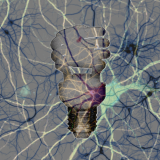Talking About Ideas
How we use ideas is shaped by how we talk about them, the exact words we use. So how do we communicate about the nature of ideas, which are notoriously abstract? With metaphors. whereideascomefrom is a site about metaphors about ideas. Why is this important? Because ideas are at the core of what makes us human, just as words are. And the complex interaction of words and ideas is critical to how we work, create, and innovate.
read moreIdeas in Space
When do we employ a spatial metaphor in talking about ideas? Any time we use a word or phrase which implies discovery, distance or direction. For example, when we say: I’m looking for a solution. She’s thinking outside the box. This concept is going in a different direction. When we’re using a spatial metaphor to talk about ideas, we’re assuming that: an idea is an independent something, an object or an entity or just a definable set of characteristics; and … the idea can be placed in some relationship to a spatial system, e.g. a set of coordinates along abstract dimensions. The notion that an idea exists separately from the individual thinking it may be related to the earliest carvings and cave paintings, attempts to convey or record the reality of an animal separate from the hunter’s memory. Plato elaborated this impulse in his Theory of Forms, to the point where the “ideal” concept existed prior to and separate from human thought. We don’t have to go as far as Plato in assuming that ideas are real and ideal. We can use the “prior existence” of ideas as simply part of the metaphorical framework we use to talk about ideation, because it can be helpful in developing methodologies and exploring our own assumptions. In this formulation, we don’t invent or “give birth” to an idea, it exists already and we discover it. In order to find it, we have to look at the right place in some abstract “idea space”. The space is defined by any number of dimensions, which measure the characteristics of the ideas. For example, a particular type of apple might be located in a space defined by its physical properties. One dimension might be color; a second dimension, size; a third, taste; etc. A Granny Smith apple would be located at the intersection of: color: green size: medium taste: tart Given enough dimensions, we can uniquely characterize a Granny Smith apple. But characterization is not the major value of the exercise. Once we’ve navigated to the intersection where the Granny Smith apple is located, we can easily find another apple with slightly different characteristics. A little farther along the color line, we might find a Honey Crisp or a Fuji, much redder. Take a left at taste and a little up on the size dimension, and you can find a Golden Delicious, much sweeter and usually a bit larger. For a product concept, such as a new toothbrush or automobile, there are many more dimensions, including functional, market, and branding characteristics. And we can find similar product concepts (all potential innovations) just by walking a little farther in one direction or another. Off the bat, using a spatial metaphor as a cognitive framework has a number of advantages. We can always find new ideas simply by defining the characteristics of the original idea as dimensions and then looking for variations, either small or large (near or far away). We can systematically vary different characteristics and create new combinations, sometimes radical ones, but still map the ideas in relationship to each other. We can look for ideas in specific places, for example, between two old ideas, or in a completely different quadrant of the idea space. And we have a built-in matrix for filtering ideas, based on one or more dimensions of the idea space we’ve...
read moreIdeas Are Born
The most common metaphors we apply to idea creation are what I call “generative” metaphors. An idea arose; we came up with it; it popped out of my head; it grew on me. We planted the seeds of it. It sprouted, it hatched. An idea is born, it comes of age, grows old and dies. “We sat around the whiteboard and generated a bunch of ideas.” It seems clear that these are biological in essence, either botanical or zoological, or at least mytho-biological, like Athena being born from the head of Zeus. In this metaphorical universe, an idea starts as a seed or egg. It has a kind of DNA, by which it can be related to other ideas, and by which it can be traced back to its creator and beyond to earlier progenitive ideas. It has kinship with other ideas, it is part of a family. It can mutate, evolve, give birth to other ideas. Creativity as a concept is closely associated with this universe. The image of “creating” ideas could be theoretically be constructive or manipulative (about building or shaping) but is more often biological – planting, growing, procreating, incubating, fertilizing. One of the strengths of the generative metaphor is that it seems to relate to some of the unconscious processes by which ideas appear in our minds. Associative thinking, for example, calls to mind all sorts of reproductive metaphors of meiosis and cross-fertilization. Because it is so ubiquitous, the generative metaphor in particular should be examined for potentially misleading, confusing or limiting implications. Here are a few … An idea has a certain organic integrity, separateness, a boundary, almost like a cell membrane. Changing a small aspect implies surgery, mutation, evolution. You need to be in a special state of some kind in order to generate new ideas. You need to be creative or feel creative; this is a mysterious condition, which some people experience more than others. My idea is my idea, because it has my DNA. There is a proprietary link; I am its “creator”. Changing “my” idea, or “stealing” it, implies a certain amount of pain....
read moreIdeas Are Made
Last in the list of three categories of metaphors central to ideation is the “constructive” metaphor. It’s not quite as common in conversation as generative or spatial, but in many ways it’s equally important. We build on other people’s ideas, we plug one idea into another, an idea is fundamental. We work on an idea, we shape it, we tinker with it, we tear it down, we deconstruct it. I also tend to throw into this category the occasional metaphor which treats ideas as something chemical: we cook up an idea, we throw it into the mix, we refine it, we distill it down. All of these usages imply that the idea is something that is material and “made”, created consciously or affected directly by human tools and processes. One reason this category is important is because it’s an accurate representation of how ideas are manipulated at certain stages in an innovation process. Whether the original “source” of an idea is generative or spatial, at some point we grab it and start working with it consciously. At that point, it starts to become a different idea, often more complex, with more components and layers. So it’s helpful to understand that something different is also happening from a conceptual point of view. In the transition from generative to constructive, for example, the original sense of ownership may become fuzzy or lost. The idea (which at this point is an assembly of different ideas) may seem less original and organic. In the transition from spatial to constructive, we may lose a clear sense of where the idea is in relationship to similar ideas … it can be harder to see the possible variations in the key dimensions of the idea, and so the original choices become “set in stone”. Nevertheless, it’s a necessary transition. We need to work on ideas to make them useful. Simple ideas need to get more complex as they move to implementation. Being conscious that we’ve shifted to a constructive metaphor is tremendously useful in managing the...
read more(Brain)Storming
Brainstorming represents the relatively rare weather metaphor in ideation. And yet it captures some very important underlying realities. It suggests the chaotic, even random, experience of ideation, particularly in early stages, and the sense that a lot of energy (both heat and light) is invested and/or produced. This image may be truer to the underlying processes of associative thinking than some of the more organic or intentional metaphors.
read more




